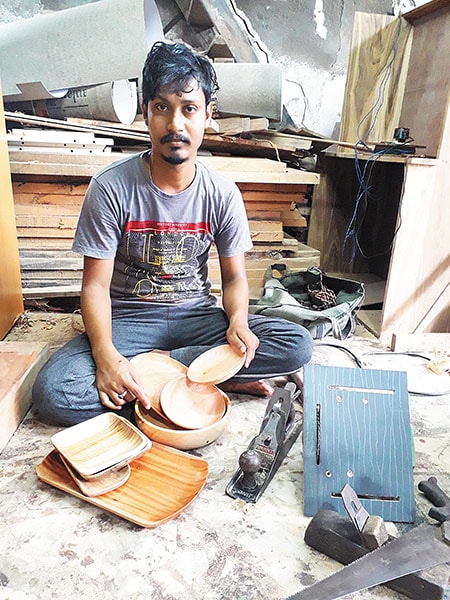Unlocking the digital door
The pandemic and change in consumer buying patterns have prompted individual sellers as well as large and small businesses to take the ecommerce route for survival


 Ashish Das of Cacia Wooden Crafts, who used to sell his products at exhibitions, has been a seller on Amazon since the lockdown
Ashish Das of Cacia Wooden Crafts, who used to sell his products at exhibitions, has been a seller on Amazon since the lockdown
Ashish Das had a thriving business. The owner of Cacia Wooden Crafts in Kolkata, West Bengal, used to sell wooden home accessories and kitchenware at exhibitions. But then came the coronavirus outbreak and subsequent lockdowns since March-end which put him in a spot. “I had no money,” recalls Das. Luckily, however, three days before the lockdown was imposed, he had set up an account on ecommerce platform Amazon to earn some additional money. And, as he points out, “what was supposed to be ‘side income’ ended up becoming my only income.” Das has a collection of over 100 products, and has listed 30 on Amazon for now. “Through them, I am earning about ₹30,000 to ₹35,000 a month. I plan to have close to 150 products on Amazon soon,” says Das, who concedes that the money isn’t close to what he earned from exhibitions. “But I have no complaints… if I wasn’t selling online, I don’t know how I would have survived.”
Das is just one of many sellers who never imagined ecommerce would be their focus, and means of survival, at any point. But the pandemic and resultant consumer behaviour have prompted them to take the digital route where minimal overheads are a blessing. Many small and large businesses, too, have finally taken the digital plunge and are strengthening their virtual presence. After she started selling on LBB in May, Shweta Arora of Silayi, an apparel brand, has found new markets open up for her clothes
After she started selling on LBB in May, Shweta Arora of Silayi, an apparel brand, has found new markets open up for her clothes
The entrepreneurial bug bit Shweta Arora, 30, when her collection—designed for a photographer friend’s fashion shoot—was well-received. Enthused by the feedback, she launched apparel label Silayi in 2018 to sell cotton handloom dresses. “I rented an office in Borivali because I didn’t have enough space to keep the stock,” she says. “And then the pandemic happened. I held on to the office till April, but the cost of overheads didn’t make sense after that. So I gave it up.” Prior to Covid-19, the Mumbai-based designer sold her collection only via exhibitions, but those events stood cancelled because of the pandemic.
In May, when delivery of non-essentials started, Arora saw a ray of hope in selling via ecommerce platforms. The month after, she joined LBB as a seller and now claims to be earning ₹1 lakh to ₹1.5 lakh per month through sales. The amount is less than what she got through exhibitions and events, but she hopes to add to her revenue with a complete focus on ecommerce in the near future. Kerala-based Elite Foods always sold its products via offline channels but now executive director Danesa Raghulal is set to launch the company’s own ecommerce platform
Kerala-based Elite Foods always sold its products via offline channels but now executive director Danesa Raghulal is set to launch the company’s own ecommerce platform
“The overheads are much higher for offline events. I’ll be finding more marketplaces like LBB and have even taken an import-export licence to take my brand to international markets,” says Arora, adding that her brand’s popularity has improved, with demand from South India too, and market size has grown tremendously as well. “Now, if one design doesn’t sell in a particular area, it ends up selling in some other area.”
Like Silayi, other players who moved online have seen their market open up not only in India but also globally. One such entity is Bengaluru-based SKD Leather, which currently sells masks on Amazon. Its owner and managing director Avhinandan Singhi first set up a watch business in Delhi and then moved to Bengaluru to expand it. Nineteen years later, he has diversified into three different ventures: Watch components, leather/metal watch bands and hardware furniture fittings. Until the coronavirus outbreak, Singhi had always kept putting off the company’s shift to online. “It was always on the back burner for me,” he says.
Things would have remained the same but for the lockdowns. SKD Leather’s core business is manufacturing leather and metal watch straps for other major manufacturers, including Timex and Maxima. The lockdown was announced just when the company was about to close a deal with Titan. “It was like you are about to hit the peak and suddenly you are thrown to the ground,” recalls Singhi.
SKD Leather’s team assumed things would return to normal in a few weeks. However, as business remained shut for two months, orders started getting cancelled. “We had zero orders and no revenue. We were only spending money on retaining key people and maintaining the industry,” says Singhi, “The only way to start recovering our losses was to move online.” (Left to right) Mukesh Maheswari, Kishore Jain, Hemant Bhardwaj, Meena Bhardwaj and Amarlal M of dry fruit brand Melting Hearts set up their ecommerce website via Shopmatic[br]He chose a product that was in demand: Face masks. Singhi started manufacturing a variety of masks, including three-layer fabric ones, microfiber pieces, and four-layered items, and through Amazon’s global selling programme, started selling majorly in the US market. Although the business hasn’t recovered from its losses, Singhi claims, “In July alone, we had done sales of $15,000… this month, we will reach about $35,000. In a few months, we are likely to recover and will end up making more money.”
(Left to right) Mukesh Maheswari, Kishore Jain, Hemant Bhardwaj, Meena Bhardwaj and Amarlal M of dry fruit brand Melting Hearts set up their ecommerce website via Shopmatic[br]He chose a product that was in demand: Face masks. Singhi started manufacturing a variety of masks, including three-layer fabric ones, microfiber pieces, and four-layered items, and through Amazon’s global selling programme, started selling majorly in the US market. Although the business hasn’t recovered from its losses, Singhi claims, “In July alone, we had done sales of $15,000… this month, we will reach about $35,000. In a few months, we are likely to recover and will end up making more money.”
Even larger companies battled for survival during the lockdown. Kerala-based Elite Foods, for instance, hardly gave importance to ecommerce before the pandemic. Set up by TR Raghulal in the mid-1980s, Elite Foods, which sells products like cakes, rusk, bread, buns, snacks as well as various flours, is now run by his 26-year-old daughter Danesa, who took over in 2017. Since most of its products are perishable, it didn’t sell much online. Before the pandemic, the company only had four to five stock keeping units (SKU) like plum and other cakes listed on platforms such as BigBasket, Amazon and Flipkart.
“So far our bread was never sold online. But due to the lockdown, a whole crop of regional, smaller online players came into the picture who sold fresh produce on a day-to-day basis. With logistics in place, it opened up that space for us and we started supplying to them,” says Danesa, who is executive director.It also started selling more products on more ecommerce platforms. Currently, Elite Foods is on about 10 ecommerce platforms, with over 20 SKUs. Though for the ₹700-crore company, it will take a while for ecommerce to contribute a significant chunk to the revenue. “But we have grown by about 150 percent already… by the end of the year, we are likely to grow by about 300 percent,” she adds.
Besides, the company is also set to launch its own ecommerce platform in the next few months. “One of the biggest advantages is the kind of flexibility we can offer to our customers on our platform. On other platforms, it’s easy to get lost among so many brands,” says Danesa, adding that this is where an offline store has an advantage—a customer gets to see two to three types of products.
Dry fruit brand Melting Hearts opened its first flagship store in Bengaluru in February. When the brand was launched in October 2019, Hemant Bhardwaj and team started by selling products in modern retail stores. They then moved to a flagship store and subsequently ecommerce sites. Everything was moving as per plan till Covid-19 struck. “Two days ahead of Covid-19, we had gone online on Amazon.in, but due to the nationwide lockdown, all non-essential products, including ours, were dropped,” recalls Bhardwaj. With malls shut too, there was no flow of revenue. To keep the business running, Melting Hearts set up its own ecommerce website via Shopmatic, an ecommerce solutions provider.
As the country unlocked in phases, the brand’s products became available everywhere. But unlike pre-Covid, “the revenue breakup is 80 percent via my website and 20 percent offline,” says Bhardwaj. The revenue share from its own website is higher compared to other platforms such as Amazon or Flipkart where it has a presence. “The full range of our products is not available there and a part of the price also needs to be paid to them,” says Bhardwaj, adding that the brand is crossing a run-rate of ₹6 to 8 lakh a month, selling across India. “We never imagined we’d get orders from the interiors of Jammu & Kashmir and Assam,” he says.The ticket size too has increased from ₹300 pre-Covid to ₹1,000 now, he adds.
According to the Deloitte Global State of the Consumer Tracker, there has been an increase of close to 20 percent in online spending in household goods, groceries, medicines, apparel, footwear and basic electronics. A KPMG report titled ‘Time to open my wallet or not’ says post Covid-19, the preference for buying via online channels has increased by 24 percent while 40 percent respondents said they prefer buying in offline stores.
“It was the shutdown of physical stores that led our consumers to rethink their shopping habits,” says Porus Doctor, partner and consumer industry leader, Deloitte India. “People who were previously reluctant to shop online have little choice today. And now that they are used to the convenience of online shopping, consumers are going to be slow in moving back to the brick-and-mortar format.”
ONLINE GAMBIT
Ecommerce platforms have seen a massive jump in the number of online sellers since Covid. And the platforms are facilitating a smooth transition for them.
Flipkart, for instance, saw a 125 percent increase in new sellers signing up on the platform in April-June compared to its existing seller base. “To help medium and small enterprises (MSME) and sellers through this pandemic, Flipkart introduced a health insurance plan, specific to Covid-19, to cover the sellers along with their families and employees,” says Rajneesh Kumar, chief corporate affairs officer, Flipkart Group.
The ecommerce giant is also helping online sellers who face manpower issues through its fulfilment services. “To address the issue of lack of working capital, we have a programme where sellers can avail credit at competitive interest rates with an approval time of one day and disbursal within 48 hours,” adds Kumar.
Similarly, Snapdeal started manually on-boarding in order to support first-time sellers who may not be comfortable with the automated process. “During the lockdown, we also waived the cancellation penalty for sellers. We extended the delivery timelines for sellers to plan their order fulfilment as per the local operating conditions,” says a Snapdeal spokesperson, adding that the platform added over 10,000-plus sellers during the pandemic.
For the convenience they offered, neighbourhood shops were the most-sought-after during the lockdown. In May, Amazon India announced a new programme, among many others, called Local Shops on Amazon that enables offline retailers to come online. Since the easing of the lockdown, over 11,000 offline retailers have joined this programme to help scale up their business. “The launch of seller registration and account management services in Hindi are also driving a lot of interest from new sellers from untapped geographies like Darbhanga in Bihar, Barmer in Rajasthan, Mahoba in Uttar Pradesh, Hailakandi in Assam, and Bardhaman in West Bengal,” says Pranav Bhasin, head-MSME empowerment & seller experience, Amazon India. He claims Amazon saw a 50 percent increase in new seller registration.
LBB, on the other hand, saw its seller base expand to Tier II and III cities. “We’ve seen a 10x growth in inbound leads from merchants wanting to digitise their business and our monthly merchants on-boarded for ‘Shop on LBB’ has grown 5x,” says Akshita Zutshi, AVP merchant on-boarding & growth, LBB. “A merchant who, say for instance, took 45 days—from sending us their lead to converting to a seller on LBB—was now taking only five to seven days,” says Suchita Salwan, co-founder, LBB.
Not only as an ecommerce platform, but LBB also helps with discoverability. Says Salwan, “Every merchant has realised that you need to have some sort of digital presence… be it as a seller or by ensuring their catalogue is available for users to browse online, even if the purchase is to happen offline. Due to the pandemic, they know the importance of having diversification in their distribution channels.”
Primarily a lifestyle brand marketplace, LBB has now expanded its ‘Shop for LBB’ to include categories like home decor, food & beverages and beauty. While LBB takes care of most services, including cataloguing and logistics, Salwan adds, “We are working on a tie-up with GPay Spot and PhonePe, wherein our partner brands can set up their own mini stores on these digital wallets through LBB.”
Like the others, Shopmatic also claims to have seen a 200 percent growth in transactions, revenues and GMV (gross merchandise value). “Previously, merchants would not be so focussed on creating their online stores, and giving their business the added push we’re happy to see a sea change in their attitudes now,” says Shenaz Bapooji, CMO at Shopmatic Group. The Singapore-based company has seen an increase in the number of sellers, including those selling cookies, pickles and art via their own webstores created on Shopmatic.
Kirana stores, in particular, have seen a lot of traction since the Covid outbreak. “In order to cater to such needs, we have launched relevant solutions, especially for these grocery stores. It is a pre-populated catalogue of a lot of products that people generally buy. All the merchant needs to do is update them,” explains Anurag Avula, CEO & co-founder of Shopmatic. As the number of sellers grew, the team dialled up its support services, including more active chats, webinars and calls with merchants. It even helped them create websites at a nominal cost, whenever required.
THE WAY FORWARD
From a small kirana store that used to sell homemade ghee in Rajasthan, Shiv Shakti Foods is now a full-fledged family-run business. Bharat Kumar’s family moved from Rajasthan to Surat in 2010 after which they bought a factory and began manufacturing and distributing ghee across the country. Since March, they have been selling ghee via Flipkart. Initially, Kumar was apprehensive about moving online. “We had a lot of existing business work to deal with. Spending time registering online, listing our products, checking orders, packing, shipping were beyond our bandwidth,” he says.
The company did not incur major losses, but its offline business slowed down. “We have already received 100-plus orders from Flipkart and earned more than ₹70,000 in such a short time,” says Kumar. In the near future, the family intends to hire someone to look after the online business. “Some customers also buy in bulk from us, so we want to spend more time and increase our focus on selling online,” he adds.
Most sellers—large and small—are certain about having a significant online business strategy. The future for some like Silayi’s Arora might be entirely online driven, while others like Singhi of SKD Leather and Bhardwaj of Melting Hearts may opt for a combined model.
“We are going to see a phygital model, a hybrid between a physical and a digital model. Both are going to be working more closely together, but the share for online will continue growing, and that trend is irreversible,” says Doctor of Deloitte.
First Published: Oct 01, 2020, 11:12
Subscribe Now